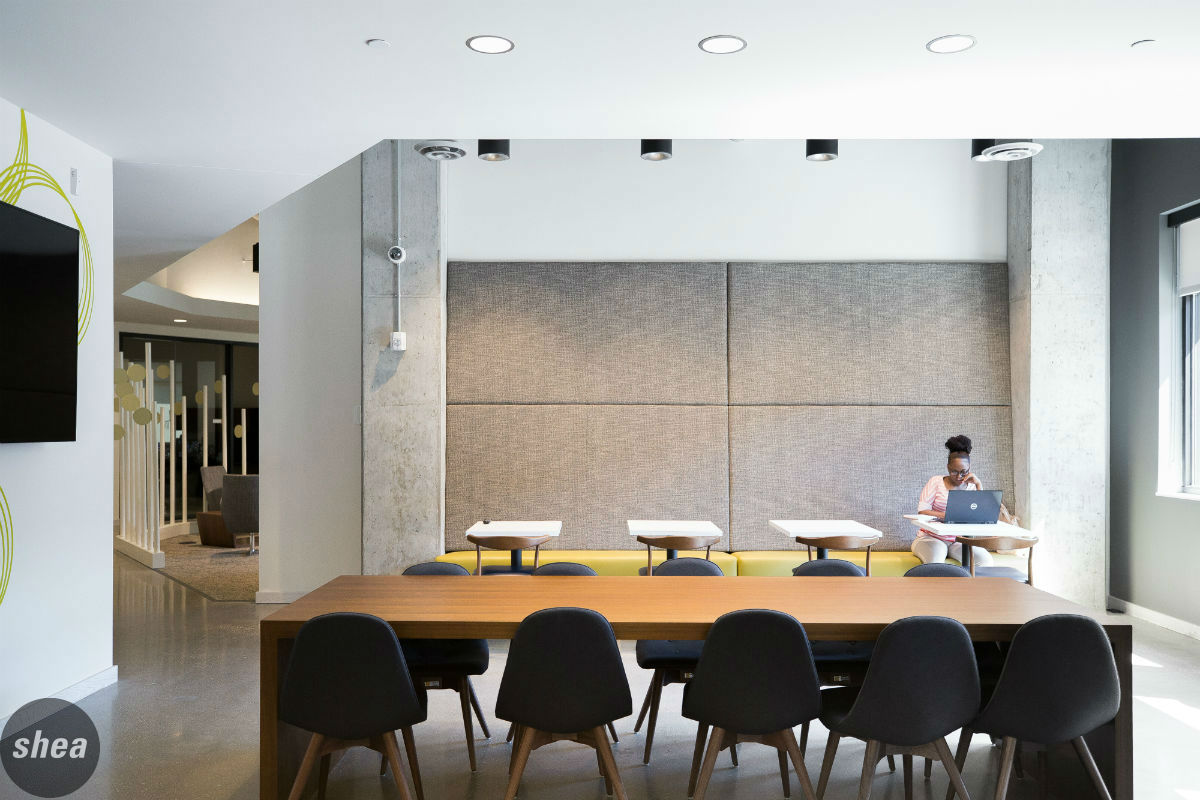At Shea, we pride ourselves on staying on top of what’s happening in design news. It helps us keep tabs on what’s fresh, inspiring, and happening in the world—and we make a few headlines of our own, too. Here are some recent articles delving into design, experience, and what’s buzzing in our community:
“The Future of Twin Cities Office Space” – Minneapolis-St. Paul:
A look at the Twin Cities office market and how it will be impacted by the pandemic and the differences that will be expected when workers return—starting with Marvin’s Warroad office, with more natural light and more “me-and-we” zones. Experts suggest that the next generation of office space will emphasize feelings of autonomy, competence, and relatedness—with in-office work being crucial to the last one. Offices will need to be designed to create a sense of connection while letting employees “design their own day” and creating more flexibility for workers—maybe with multiple offices for the “hub and spoke” model.
“Designing an Inclusive Restaurant” – Restaurant Development + Design:
This piece looks at how restaurant design can be a contributing factor in creating an inclusive space, reflecting all different aspects of diversity. Some groups to consider include the span of genders, races, ages, and abilities, and the article makes the case that an inclusive design can create a richer experience for the guest. Mobility and sound are especially important in terms of age and ability. Taking traditional as well as nontraditional gender considerations into account in design is important to ensure customer comfort, and keeping a sharp eye for signs of cultural appropriation is important. Every consumer touchpoint is an opportunity for inclusion and a repeat visit.
“Shea-Designed Josefina is Wayzata-Bound” – Shea:
The Star Tribune and Minneapolis-St. Paul magazine give the scoop on Roman/Italian restaurant Josefina, designed by Shea and coming soon to Wayzata.
“The Exhilarating World of Post-Pandemic Shopping” – Fast Company:
With brick-and-mortar retail revenues down by 14% during the pandemic, stores are being forced to reimagine the shopping experience—and focus on the most pleasurable parts of in-store shopping (discovering new products, enjoying in-store entertainment). While this has been happening slowly over the past five years as e-commerce has been on the rise and brick-and-mortars have strived to compete, COVID has fast-tracked it. The next phase of experiential retail will emphasize (sometimes exclusively) intentional shopping and the ”fun stuff”—the discovery, socializing, browsing, and learning—and actual product will be ordered and delivered to customers’ homes. Stores and shopping areas will become more community spaces that provide a connection to other customers.
“7 Ways COVID-19 Continues to Impact Hospitality Design” – Architectural Digest:
Architectural Digest speaks with hospitality designers about how they’ve coped through the pandemic, what will remain changed in the long term, and what a new normal will look like eventually. Health and wellness will continue to be prolific in design—natural light, ventilation, and opportunity for connection. Open plans that feel expansive and an increased importance of outdoor space are here to stay. Hospitality design will continue to intersect with healthcare design, and space flexibility will be key going forward. Virtual engagement will still be important in hospitality, and hotels will emphasize local experiences more than ever rather than solely catering to travelers. Finally, all industries are looking to a big boost this year as people start getting out again, meaning more openings, more energy, and more celebration in hospitality spaces.
“At New York Restaurants, It’s the Season of the Yurt” – New York Times:
The New York Times food critic brings his skills to the different outdoor street-dining structures that have cropped up around the city. He explores the impact of eating in a shed, bubble, yurt, or tent on the overall hospitality and dining experience, and weighs in on which ones are on the higher end of style and sophistication—and the price that comes with that experience. He also discusses the impact on service and training, and how restaurants can find structures that are in keeping with their brands and other design elements.
“The Effects of Covid-19 On the Workplace: Reinforcing Culture, Creating an Amenity” – Work Design:
More and more companies are returning to their offices in a post-COVID flurry—and those companies are looking to answer the question of why the traditional workplace is still necessary. Design can help solve that issue, ensuring that the act of coming to the office is purposeful and value-driven. Culture and company loyalty in the workplace can be reinforced through design, but it can also help the workplace be an amenity that attracts workers and makes them want to spend time in their corporate spaces. That physical space needs to reflect company values and support employees to ensure they can be as efficient as possible, and include spaces for them to build community and social connections. A shift in space-planning strategy is one solution, and this piece dives deep into how a shift in space allocation can help offices stay modern and productive.
“From Empty Mall to Community Asset” – Finance & Commerce:
The “mall issue” is one that was prevalent before the pandemic, but vacant spaces in shopping malls are at higher rates than ever. Anchor stores, in particular, are falling to the wayside and leaving vast expanses of empty real estate. Some malls fill these with experiential retail or offices, while others utilize the parking space to sell off for other buildings, including housing. It’s an exercise in real-estate creativity as firms begin to transform malls into mixed-use community destination spots (such as Rosedale, which now has a food hall and will soon include office space and multi-family housing, with potential hotel, more retail, and community space to come).
“Grocery Stores Were Already in Flux. The Pandemic Could Change Them Forever” – Fast Company:
Post-pandemic, the architectural functionality and aesthetics of grocery stores will be different from the recent past. Fast Company notes that stores have been trending smaller and becoming more neighborhood-oriented in the past several years, and the pandemic has seen the rise of multiple entries for in-store shopping and in-and-out pickup (along with the utilization of parking-lot space for a curbside pickup area or drive-through). Self-serve and hot-food bars are on the decrease, and that prep will shift to back-of-house, where there will have to be room for creating prepackaged meals and preparing orders for delivery and pickup. Finally, checkout lines will transform to create more space and embrace the emerging “no-checkout” technology.
January 22, 2021
Shea Links: January

